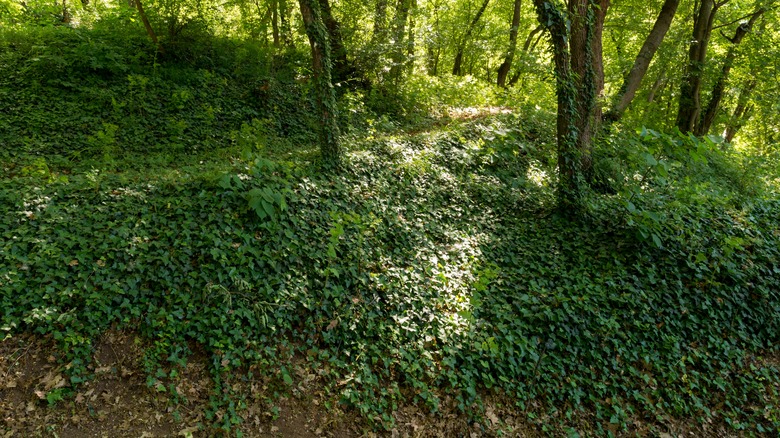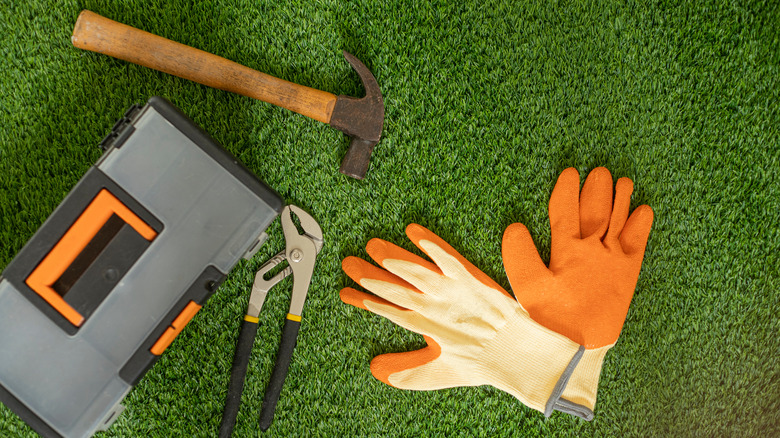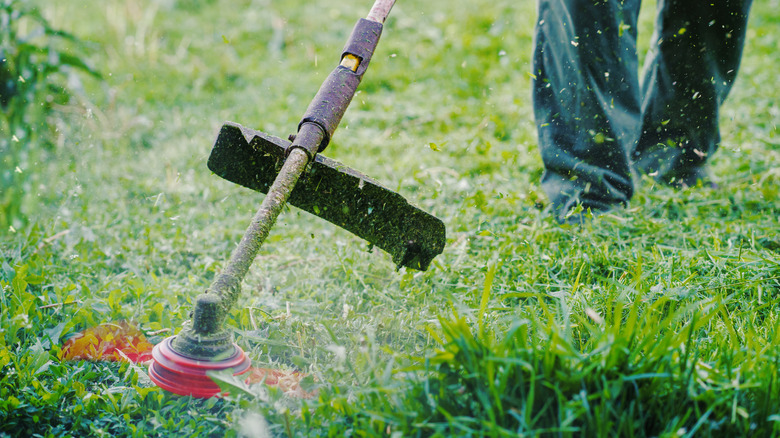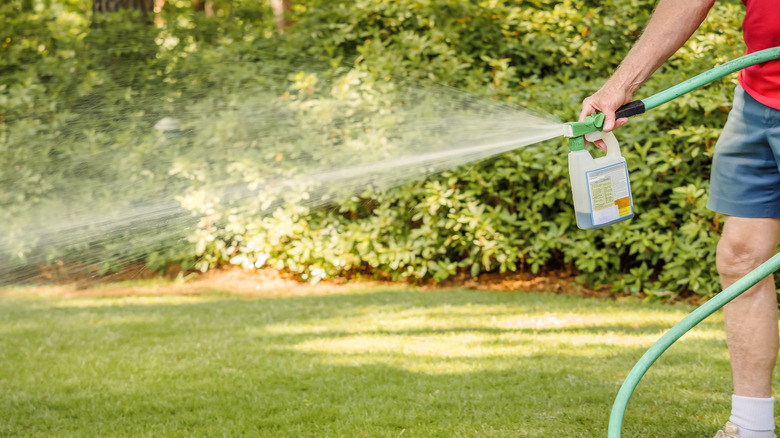How To Get Rid Of Ivy Ground Cover
Ivy plants and vines, also known as hedera helix or English ivy, are loved by indoor and outdoor gardeners for their romantic shape and growth pattern. Many people grow the ivy plant either on the side of their homes or as ground cover since they're low-maintenance. As Gardening Know How points out, the English ivy grows best in the shade, making it a beautiful plant to grow alongside the trees in your yard and areas where grass doesn't get enough sun.
But ivy isn't everyone's cup of tea. Its incredible benefits — quick growing, low maintenance, and persistence — moonlight as its drawbacks. Ivy plants have been known to damage structures as their roots grow longer and stronger, strangling surrounding greenery. If you've decided to remove the ivy ground cover from your yard, you're likely to face a tough, seemingly never ending battle. This plant is tough to get rid of, and once it's rooted, it's not going anywhere without some serious intervention. Luckily, there are methods of getting rid of English ivy permanently, as long as you're ready for the battle ahead.
Prepare and protect
Before diving into your ivy removal endeavor, it's imperative to take the necessary measures to protect yourself and your yard. While hedera helix isn't nearly as poisonous as the notorious poison ivy (Toxicodendron radicans), contact with the plant can still command an allergic reaction in some people, according to the North Carolina Cooperative Extension. The rash can be as mild as itchy red skin to more severe, raised, weeping blisters. Bob Vila recommends wearing long sleeves, long pants, and sturdy garden gloves to avoid the threat.
There are also a few environmental preparations to make. Most of the chemicals you'll use to kill the ivy ground cover will need to be applied in weather no cooler than 60 degrees Fahrenheit and no hotter than 90 degrees Fahrenheit. Make sure the weather won't be windy on the day of the job and the next couple of days to prevent the plant from getting blown onto the surrounding plants. The same can be said of the rain. If you're concerned, consider putting a temporary plastic tarp over nearby plants you don't want to be affected by the chemicals.
Cut the ivy
Before dousing your ivy patches in herbicides, you must prep your yard thoroughly and extensively. As the Pretty Handy Girl points out, one of the reasons ivy plants are so hard to kill is because the wax on their leaves makes them very resistant to herbicides and other topical chemicals. To make it vulnerable to herbicides, you'll need to find a way to cut open and expose the leaves. The simplest way to do this is with a simple push mower. There are some flaws in this method, though. If there are any rocks or thick roots under the leaves, they could mess up your mower. Also, as Bob Vila notes, the mower will only shred the leaves, leaving the roots and vines still attached.
The best method to get the ivy prepared for chemicals can be a little time-consuming, but it will, hopefully, only need to be done once. Begin by using a brush cutter or any other heavy-duty garden cutter to cut the leaves off and uproot them from the earth. This can also be done with garden shears, but it will take more time and effort. Work in 2 feet sections to be most effective, and just cut straight through the root. Then, roll it up like a rug, making sure the roots come up with it.
Apply your herbicide
Make sure that the entirety of the root system has been dug up before proceeding to the next step, as even a little bit left behind can root itself, causing all your hard work to be rendered pointless. Also, immediately throw away the ripped-up ivy so it doesn't try to reroot.
Now it's time to apply the herbicide. There are generally two options for herbicides, chemical or natural. If your ivy problem is severe, it's a good idea to stick with more potent chemical herbicides. While plenty of herbicides market themselves as effective ivy killers, Bob Vila recommends looking for ones with the chemicals glyphosate, imazapyr, or triclopyr — or all three. If you want to go the more natural route, swap the herbicide for a large amount of vinegar.
To apply the herbicide, spray or thoroughly apply it to the affected, cleared-out area. Keep pets and children away from the patch (unless using vinegar). Monitor your yard and closely examine it for any new ivy roots after a couple of weeks. If you find any, uproot them and reapply your herbicide of choice.



